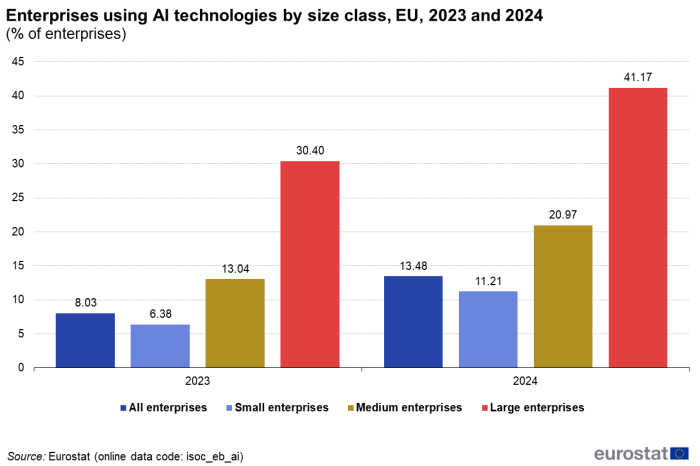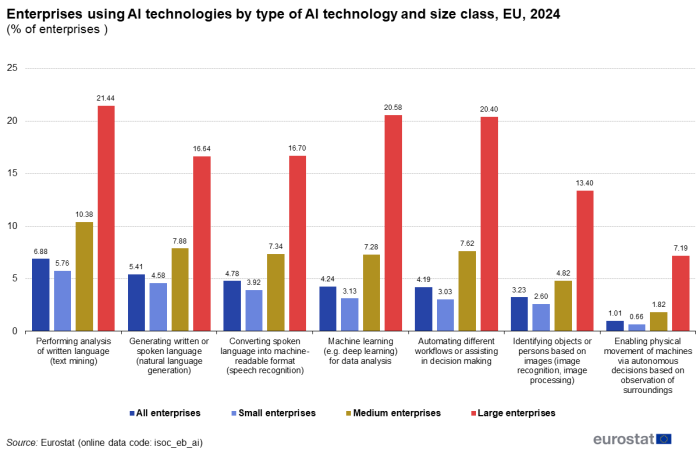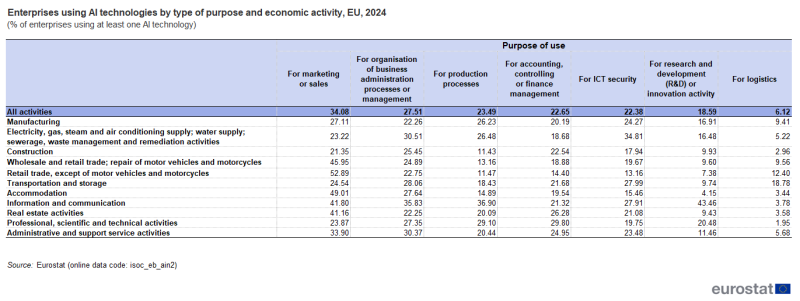Data extracted in January 2025
Planned article update: January 2026
Highlights
In 2024, 13.48% of EU enterprises used AI technologies.
In 2024, 41.17% of large EU enterprises used AI technologies.
In 2024, AI was used the most by enterprises in the information and communication sector.
Enterprises using AI technologies, 2023 and 2024
Country codes
This article presents recent statistical data on the use of artificial intelligence (AI) technologies by EU enterprises. AI is developing quickly and can bring many benefits, such as safer and cleaner transport, more efficient manufacturing, cheaper and more sustainable energy, and better decision-making. AI refers to systems that use technologies such as text mining, computer vision, speech recognition, natural language generation, machine learning or deep learning. These technologies can be used to gather and/or use data to predict, recommend or decide, with varying levels of autonomy, the best action to achieve specific goals. AI systems can be software-based (e.g. image recognition software, virtual assistants, speech and face recognition systems) or embedded in devices (e.g. autonomous robots, self-driving vehicles, drones).
Enterprises using artificial intelligence technologies
In 2024, 13.48% of enterprises in the EU, with 10 or more employees and self-employed persons, used at least one of the following AI:
- technologies analysing written language (text mining)
- technologies converting spoken language into a machine-readable format (speech recognition)
- technologies generating written or spoken language (natural language generation)
- technologies identifying objects or people based on images (image recognition, image processing)
- machine learning (e.g. deep learning) for data analysis
- technologies automating different workflows or assisting in decision-making (AI based software robotic process automation)
- technologies enabling machines to physically move by observing their surroundings and taking autonomous decisions.
Compared with 2023, the use of AI technologies increased by 5.45 percentage points (pp) (Figure 1).
As shown in Figure 1, large enterprises used AI more than small and medium enterprises. In 2024, 11.21% of small enterprises, 20.97% of medium enterprises and 41.17% of large enterprises used AI. This difference might be explained, for example, by the complexity of implementing AI technologies in an enterprise, economies of scale (i.e. enterprises with larger economies of scale can benefit more from AI) or costs (i.e. investment in AI may be more affordable for large enterprises).

(% of enterprises)
Source: Eurostat (isoc_eb_ai)
Comparing enterprises using at least one AI technology among EU countries (Figure 2) shows that the share of enterprises using AI ranged between 3.07% and 27.58%. The highest share was recorded in Denmark (27.58%), followed by Sweden (25.09%), and Belgium (24.71%), while the lowest shares were recorded in Romania (3.07%), Poland (5.9%) and Bulgaria (6.47%). In 2024, all EU Member States recorded higher shares of enterprises using AI technologies compared with 2023. The highest increase was recorded in Sweden (14.72 pp) and the lowest was reported in Portugal (0.77 pp).

(% of enterprises)
Source: Eurostat (isoc_eb_ai)
As shown in Figure 3, in some economic activities AI is used a lot more than in others. This might indicate that AI is more relevant for certain activities. In 2024, the information and communication sector (with 48.72%) and professional, scientific and technical service activities (with 30.53%) stood out with the highest share of enterprises that used AI. In all other economic activities, the share of enterprises using AI was below 16%. This ranged from 15.45% (real estate activities) to 6.09% (accommodation and construction).

(% of enterprises)
Source: Eurostat (isoc_eb_ain2)
Types of AI technologies used
EU enterprises used different types of AI technologies. As presented in Figure 4, there was no predominant AI technology. The AI technologies used slightly more often were AI technologies performing analysis of written language (i.e. text mining). In 2024, these AI technologies were used by 6.88% of enterprises. AI technologies generating written or spoken language (natural language generation) followed with 5.41% of enterprises. AI technologies converting spoken language into a machine-readable format (speech recognition), machine learning (e.g. deep learning) for data analysis, technologies automating different workflows or assisting in decision making and technologies identifying objects or persons based on images (image recognition, image processing) were each used by between 4.78% and 3.23% of enterprises. AI technologies enabling machines to physically move by observing their surroundings and taking autonomous decisions (e.g. self-driving vehicles) were used by 1.01% of enterprises.
Although there was no predominant AI technology used by all enterprises, Figure 4 shows a different situation when looking at the size of the enterprises, in particular large enterprises, where AI technologies performing analysis of written language (text mining) were the most used technologies with 21.44%, followed by machine learning for data analysis (20.58%) and by AI technologies automating different workflows or assisting in decision-making (20.40%). The least used AI technologies were those enabling physical movement of machines via autonomous decisions based on observation of surroundings (7.19%).

(% of enterprises)
Source: Eurostat (isoc_eb_ai)
Table 1 presents the different types of AI technologies used in different economic activities. In the information and communication sector, where the highest share of enterprises using AI was recorded, the most used AI technologies were text mining (30.11%), followed by natural language generation (25.83%) and machine learning for data analysis (25.66%). In professional, scientific and technical service activities, text mining was again the most used AI technology with 15.61% of enterprises, followed by speech recognition (12.49%) and natural language generation (11.51%). In all other activities, the shares of enterprises using specific AI technologies ranged from less than 1% to 8.06%.

(% of enterprises)
Source: Eurostat (isoc_eb_ain2)
Purpose of using AI software or systems
EU enterprises used AI software or systems for different purposes. In 2024, 34.08% of enterprises using AI technologies used these software or systems for marketing or sales and 27.51% for the organisation of business administration processes or management. AI software or systems for logistics were, with a share of 6.12% of enterprises using AI technologies, used the least (Figure 5).
The purposes for which enterprises used AI software and systems differed depending on their size. The biggest difference between small and large enterprises was recorded for those that used AI software or systems for ICT security (46.44% large enterprises, 17.19% small enterprises), followed by those which used them for production processes (34.65% large enterprises, 21.62% small enterprises) and those that used them for logistics (15.85% large enterprises, 4.48% small enterprises) (Figure 5).

(% of enterprises using at least one AI technology)
Source: Eurostat (isoc_eb_ai)
Enterprises used AI technologies for different purposes depending on the branch of the economy in which they were operating. In the manufacturing sector, AI software or systems were used mostly for marketing and sales (27.11%) and for production processes (26.23%), while AI software or systems were mostly used for ICT security in the electricity, gas, steam, air conditioning and water supply sector (34.81%). The main use for AI was research and development (R&D) or innovation activity in the information and communication sector (43.46%). Enterprises mainly used AI software or systems for marketing or sales in the retail trade sector (52.89%) and in the accommodation sector (49.01%) (Table 2).

(% of enterprises using at least one AI technology)
Source: Eurostat (isoc_eb_ain2)
Source data for tables and graphs
Data sources
Source: Data presented in this article are based on the results of the 2024 EU survey on 'ICT usage and e-commerce in enterprises'. Statistics were obtained from the surveys conducted by National Statistical Authorities in the first months of 2024.
Sample: In 2024, 157 000 of the 1.54 million enterprises in the EU were surveyed. Of the 1.54 million enterprises, approximately 83% were small enterprises, 14% medium and 3% large enterprises.
Main concepts: The observation statistical unit is the enterprise, as defined in the Regulation (EC) No 696/1993 of 15 March 1993. The survey covered enterprises with at least 10 employees and self-employed persons. Enterprises are broken down by size: small enterprises (10-49 employees and self-employed persons), medium (50-249 employees and self-employed persons) and large (250 or more employees and self-employed persons). Economic activities correspond to the classification NACE Revision 2.The sectors covered are manufacturing, electricity, gas and steam, water supply, construction, wholesale and retail trades, repair of motor vehicles and motorcycles, transportation and storage, accommodation and food service activities, information and communication, real estate, professional, scientific and technical activities, administrative and support activities and repair of computers and communication equipment.
Data: Unreliable data are included in the calculation of European aggregates. Data presented in this article may differ from the data in the database on account of updates made after the data extractions used for this article. Data in the database are organised according to the survey year.
Context
In 2019, the new European Commission President, Ursula von der Leyen, described how she wanted the EU to grasp the opportunities presented by the digital age. A Europe fit for the digital age is 1 of 6 Commission priorities for the period 2019-2024. Such a digital transformation is based on the premise that digital technologies and solutions should: open up new opportunities for businesses; boost the development of trustworthy technology; foster an open and democratic society; enable a vibrant and sustainable economy; help fight climate change. With this in mind, during February 2020 the European Commission adopted an overarching presentation of the Commission's ideas and actions for Shaping Europe's digital future, as well as specific proposals in relation to:
- A European strategy for data (COM(2020) 66 final) which seeks to promote the EU as a leading role model for a society empowered by data to make better decisions — in business and the public sector; and
- a White Paper on Artificial Intelligence — A European approach to excellence and trust (COM(2020) 65 final) which supports a regulatory and investment oriented approach with the twin objectives of promoting the uptake of artificial intelligence and addressing the risks associated with certain uses of this new technology.
In 2021, the Digital Compass for the EU's Digital Decade (COM(2021)118 final), set the EU's digital targets for 2030 evolving around 4 cardinal points: skills, digital transformation of businesses, secure and sustainable digital infrastructures and digitalisation of public services.
Explore further
Other articles
- Digital economy and society statistics - enterprises
- E-commerce statistics
- E-business integration
- Use of Internet of Things in enterprises
- Cloud computing - statistics on the use by enterprises
- ICT specialists - statistics on hard-to-fill vacancies in enterprises
- ICT security in enterprises
- Social media - statistics on the use by enterprises
- Impact of COVID-19 on e-sales of enterprises
- Impact of COVID-19 on the use of ICT in enterprises
- Online meetings and remote access to enterprise resources - statistics
Database
- ICT usage in enterprises (isoc_e)
- E-business (isoc_eb)
- Artificial intelligence by NACE Rev.2 activity (isoc_eb_ain2)
- Artificial intelligence by size class of enterprise (isoc_eb_ai)
- E-business (isoc_eb)
Thematic section
Publications
Selected datasets
Methodology
External links
Legislation
- Regulation (EU) 2019/2152 of the European Parliament and of the Council of 27 November 2019 on European business statistics
- Regulation (EC) No 808/2004 of the European Parliament and of the Council of 21 April 2004 concerning Community statistics on the information society
- Regulation (EC) No 960/2008 of 30 September 2008 implementing Regulation (EC) No 808/2004 concerning Community statistics on the information society
- Regulation (EC) No 1023/2009 of 29 October 2009 implementing Regulation (EC) No 808/2004 concerning Community statistics on the information society
- Regulation (EU) No 821/2010 of 17 September 2010 implementing Regulation (EC) No 808/2004 concerning Community statistics on the information society
- Regulation (EU) No 937/2011 of 21 September 2011 implementing Regulation (EC) No 808/2004 concerning Community statistics on the information society
- Regulation (EU) No 1083/2012 of 19 November 2012 implementing Regulation (EC) No 808/2004 concerning Community statistics on the information society
- Regulation (EU) No 859/2013 of 5 September 2013 implementing Regulation (EC) No 808/2004 concerning Community statistics on the information society
- Regulation (EU) No 1196/2014 of 30 October 2014 implementing Regulation (EC) No 808/2004 concerning Community statistics on the information society
- Regulation (EU) 2015/2003 of 10 November 2015 implementing Regulation (EC) No 808/2004 concerning Community statistics on the information society
- Regulation (EU) 2016/2015 of 17 November 2016 implementing Regulation (EC) No 808/2004 concerning Community statistics on the information society
- Regulation (EU) 2017/1515 of 31 August 2017 implementing Regulation (EC) No 808/2004 concerning Community statistics on the information society
- Regulation (EU) 2018/1798 of 21 November 2018 implementing Regulation (EC) No 808/2004 of the European Parliament and of the Council concerning Community statistics on the information society for the reference year 2019
- Regulation (EU) 2019/1910 of 7 November 2019 implementing Regulation (EC) No 808/2004 of the European Parliament and of the Council concerning Community statistics on the information society for reference year 2020
- Regulation (EU) 2020/1030 of 15 July 2020 laying down the technical specifications of data requirements for the topic 'ICT usage and e-commerce' for the reference year 2021, pursuant to Regulation (EU) 2019/2152 of the European Parliament and of the Council
- Regulation (EU) 2021/1190 of 15 July 2021 laying down the technical specifications of data requirements for the topic 'ICT usage and e-commerce' for the reference year 2022 pursuant to Regulation (EU) 2019/2152 of the European Parliament and of the Council
- Regulation (EU) 2022/1344 of 1 August 2022 laying down the technical specifications of data requirements for the topic 'ICT usage and e-commerce' for the reference year 2023, pursuant to Regulation (EU) 2019/2152 of the European Parliament and of the Council
- Regulation (EU) 2023/1507 of 20 July 2023 laying down the technical specifications of data requirements and the deadlines for submission of metadata and quality reports for the topic of ICT usage and e-commerce for the reference year 2024, pursuant to Regulation (EU) 2019/2152 of the European Parliament and of the Council
- Regulation (EU) 2024/1883 of 9 July 2024 laying down the technical specifications of data requirements and the deadlines for submission of metadata and quality reports for the topic Information and Communication Technologies usage and e-commerce for the reference year 2025, pursuant to Regulation (EU) 2019/2152 of the European Parliament and of the Council
- Regulation (EC) No 696/1993 of 15 March 1993 on the statistical units for the observation and analysis of the production system in the Community
